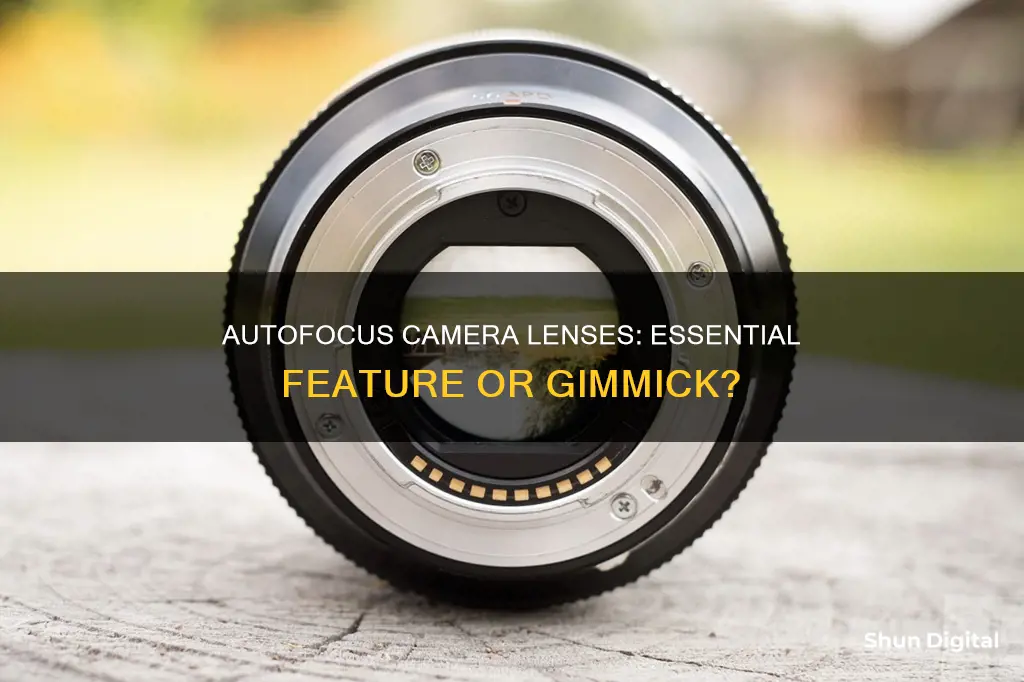
Autofocus is a crucial feature in modern cameras, allowing photographers to capture sharp images with minimal effort. The autofocus system automatically adjusts the camera lens to focus on the desired subject, ensuring the final photo is clear and in focus. This is especially important when photographing moving objects or when speed and accuracy are required, such as in sports or wildlife photography. The autofocus feature has become so advanced that it can be used for both still and moving subjects, with the camera predicting the future position of the subject to ensure it remains in focus.
The first autofocus camera was released in 1977, and since then, autofocus technology has advanced significantly. Today, autofocus is an essential tool for both amateur and professional photographers, guaranteeing clearer photos and reducing the need for image editing.
| Characteristics | Values |
|---|---|
| Purpose | To obtain focus on the subject |
| Inner workings | Sensors detect changes in contrast at a point in the image to determine maximal sharpness |
| Types | Active AF, Passive AF |
| Active AF | Emits a signal to illuminate or estimate distance to the subject |
| Passive AF | Performed using contrast detection or phase detection methods |
| Contrast detection | Uses image sensor as a contrast sensor |
| Phase detection | Uses multiple autofocus points |
| Use cases | Sports photography, wildlife photography |
What You'll Learn

Autofocus vs Manual Focus Lenses
Autofocus and manual focus lenses each have their own advantages and disadvantages, and the choice between the two depends on the specific situation and the photographer's preferences. Here is a detailed comparison of the two:
Autofocus Lenses:
- Autofocus (AF) lenses use a sensor, a control system, and a motor to automatically focus on a selected point or area.
- AF systems can rely on a single sensor or an array of sensors to determine the correct focus.
- Through-the-lens optical autofocusing is usually faster and more precise than manual focus, especially in action scenarios with moving objects.
- AF accuracy within 1/3 of the depth of field at the widest aperture is common in professional AF SLR cameras.
- AF systems work best in scenes with good lighting and contrast, as they depend on light and contrast to determine the focus point.
- Modern AF systems have additional technologies such as facial recognition and tracking, making them convenient for general photography.
- AF lenses are less suitable for macro photography, low-light conditions, or scenes with many objects, as they may struggle to find the correct focus in these situations.
Manual Focus Lenses:
- Manual focus lenses allow the photographer to have complete control over what the camera focuses on.
- They are preferred by many photographers, especially in documentary work and landscape photography, as they can manually select the object of interest.
- Manual lenses are useful when shooting through glass or wire fences, as autofocus lenses may struggle with false focusing on the fence or glass instead of the intended subject.
- Manual focus is better suited for shooting in low-contrast and low-light scenes, as it does not rely on the camera's ability to detect contrast and light.
- Manual lenses often come in sets, as the lens needs to be switched depending on the distance from the subject.
- Manual focus lenses can be slower and may require carrying multiple lenses, making them less convenient for general photography.
In conclusion, both autofocus and manual focus lenses have their strengths and weaknesses. Autofocus lenses offer convenience and speed, while manual focus lenses provide more control and are better suited for certain types of photography. Ultimately, the choice between the two depends on the specific needs and preferences of the photographer.
Pennsylvania Camera Tickets: Pay or Fight?
You may want to see also

Active AF System vs Passive AF System
Active AF System
The Active AF system is a technology from the early days of autofocus. It works by emitting an ultrasonic or infrared signal towards the subject and measuring the time it takes for the signal to bounce back to the camera. This is similar to sonar and radar technology. The Active AF system is useful in low-light environments where normal autofocus fails. However, it is only suitable for stationary, non-moving subjects and only works for close subjects. It also cannot focus through windows or on subjects very close to the camera.
Passive AF System
The Passive AF system works by detecting contrast in the image entering the optical system. It does not emit any energy such as ultrasonic sound or infrared light towards the subject. It can be achieved through phase detection or contrast measurement. Phase detection is faster and better at tracking moving subjects but is more prone to errors and internal misalignment issues. On the other hand, contrast measurement is slower but more reliable and accurate in low-light conditions.
Battery-Powered Wi-Fi Cameras: Night Vision Included?
You may want to see also

Phase Detection vs Contrast Detection
Autofocus is an important feature of modern cameras, allowing photographers to capture sharp images with ease. The two main types of autofocus systems are phase detection and contrast detection, each with its own strengths and weaknesses.
Phase detection autofocus is commonly found in DSLR cameras. It is very fast and excellent at tracking moving subjects as it doesn't require much computational power. However, it is more prone to errors and internal misalignment issues. Phase detection also doesn't work well in low-light conditions or with low-contrast subjects.
Contrast detection autofocus, on the other hand, is used in mirrorless cameras, point-and-shoot cameras, and DSLR cameras in live view mode. It is slower than phase detection as it requires the camera to process more data by constantly evaluating images to achieve focus. However, it tends to be more precise, especially with still subjects like landscapes, as the autofocus system directly measures data from the camera sensor.
Some cameras use a hybrid of the two systems, such as digital SLRs that employ contrast detection in live view or movie mode and phase detection when using the viewfinder. This combination allows photographers to benefit from the speed of phase detection and the precision of contrast detection.
In summary, phase detection is ideal for situations requiring fast and continuous autofocus, such as sports or wildlife photography. In contrast, contrast detection shines in scenarios with stationary subjects, where accuracy is more important than speed.
The Making of the First Kodak Camera
You may want to see also

Continuous-Servo vs Single-Servo Autofocus
Autofocus is an essential feature of modern cameras, allowing photographers to capture sharp images of moving subjects with ease. While autofocus is generally more convenient and accurate than manual focus, it is important to understand the different autofocus modes to make the most of this technology.
Single-Servo Autofocus
Also known as Single-Shot AF or AF-S, this mode is designed for shooting stationary subjects. When the shutter button is pressed halfway, the autofocus mechanism activates and locks the focus on the subject. The focus remains locked as long as the photographer keeps their finger on the shutter button, even if they recompose the shot. This mode ensures that the camera will not capture an out-of-focus image, as it will not release the shutter if the subject is not in focus. Single-servo autofocus is ideal for portraits, landscapes, and other scenarios where the subject is not moving.
Continuous-Servo Autofocus
Continuous-servo autofocus, or AI Servo AF (Canon), Continuous AF (Sony), and AF-C (Nikon), is designed for capturing moving subjects. In this mode, the camera continuously adjusts the focus to keep the subject sharp, even if the photographer or the subject is in motion. This mode is particularly useful for action photography, sports, and wildlife shots, where the subject may be moving erratically. Continuous-servo autofocus also excels in situations where the photographer is shooting at super-shallow apertures or very close distances, as even slight movements can cause the subject to fall out of focus.
Choosing the Right Autofocus Mode
The choice between single-servo and continuous-servo autofocus depends on the nature of the subject and the photographer's creative intentions. Single-servo autofocus is ideal for stationary subjects, as it ensures precise focus and prevents accidental capture of out-of-focus images. On the other hand, continuous-servo autofocus is essential for capturing moving subjects, as it continuously adjusts the focus to keep the subject sharp. This mode is also advantageous in situations where slight movements can cause focus issues, such as shallow apertures or close-up photography.
Charging Your SimpliSafe Outdoor Camera: A Quick Guide
You may want to see also

Autofocus Area Modes
There are several autofocus area modes available, each with its own advantages and disadvantages. Here is a description of some of the most common autofocus area modes:
- Single-Point Autofocus: The camera uses a single focusing point, selected by the user, to autofocus. This mode is suitable for situations where the camera and subject are not moving, and tracking capabilities are not required. It can be used with continuous autofocus but may struggle to track fast-moving objects across multiple points.
- Dynamic Autofocus: The user selects a single focusing point, but the camera can also utilise surrounding points to track the subject if it moves. This mode is well-suited for wildlife photography, as it allows the camera to follow the subject's movement.
- 3D Tracking Autofocus: The camera automatically follows the subject as it moves across different focusing points. Unlike Dynamic Autofocus, the user is not expected to pan the camera to keep the subject close to the initially selected point. This mode is also useful for wildlife photography but may not be as quick or accurate as Dynamic Autofocus.
- Group-Area Autofocus: The camera uses multiple autofocus points simultaneously, usually five. It gives equal priority to all the points and focuses on the nearest object detected by any of them. This mode is beneficial for challenging autofocus situations, such as photographing a fast-moving bird in flight.
- Auto-Area Autofocus: The camera automatically scans the scene and decides on the subject to focus on, often the closest object to the camera or a face. This mode gives the user less control over the focusing process.
Different camera brands may have unique names for these autofocus area modes, but the general structure and functionality remain similar. It is important to refer to your camera's manual to understand the specific autofocus area modes available to you and how to activate them.
Glass Cameras: S10e's Unique Feature
You may want to see also
Frequently asked questions
Autofocus (AF) is a feature on some cameras that automatically adjusts the focus of the lens to ensure the image is sharp.
There are two types of autofocus systems: passive AF and active AF. Passive AF uses contrast sensors within the camera to detect the optimal focus point, while active AF emits a signal to estimate the distance to the subject.
Autofocus is convenient and easy to use, allowing photographers to capture sharp images of moving subjects. It is also more accurate than manual focus in many cases, making it ideal for sports and wildlife photography.
While autofocus is generally reliable, it may struggle in low lighting conditions or with certain types of subjects. In these cases, manual focus can be used to adjust the focus more precisely.







